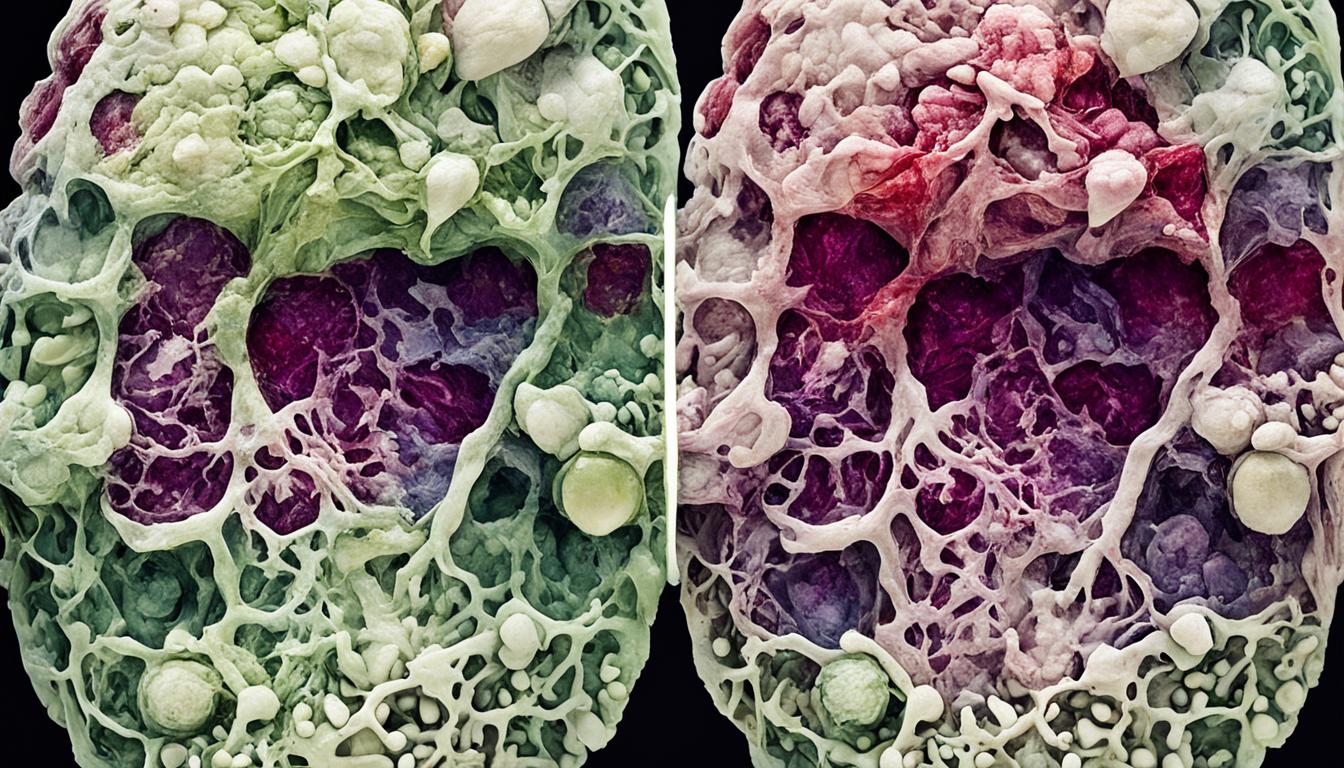Gangrene is a serious condition where tissue dies because it doesn’t get enough blood. It’s often caused by an injury, infection, or certain health problems. Risk factors for gangrene include diabetes, smoking, or a weak immune system. Symptoms of gangrene can range from changes in skin color to numbness.
There are different types of gangrene, like dry, wet, gas, and internal gangrene. Doctors diagnose it by looking at symptoms and sometimes through medical tests. Treatments usually involve surgery to remove dead tissue and antibiotics. Cutting-edge methods like stem cell therapy are also possible. Preventing gangrene is about taking good care of wounds and health problems.
Key Takeaways:
- Gangrene is a medical condition caused by a lack of blood supply, leading to tissue death.
- Common risk factors for gangrene include diabetes, peripheral arterial disease, smoking, major trauma, and a suppressed immune system.
- Symptoms of gangrene include skin color changes, numbness, pain, skin breakdown, and coolness.
- Types of gangrene include dry gangrene, wet gangrene, gas gangrene, and internal gangrene.
- Treatment options for gangrene include surgical removal of dead tissue, antibiotics, and addressing the underlying cause. Stem cell therapy may also be used in some cases.
- Prevention of gangrene involves proper wound care and management of underlying health conditions.
Causes of Gangrene
Gangrene happens when a part of the body does not get enough blood. This lack of blood supply can be due to several reasons. The main ones often include not enough blood reaching the area and infectious agents.
Some things that can increase the risk of gangrene are:
- Peripheral arterial disease
- Diabetes
- Smoking
- Major trauma
- Alcoholism
- Suppressed immune system
Problems like peripheral arterial disease and diabetes can cause gangrene. Smoking and alcoholism are risk factors, too. For example, peripheral artery disease can lead to dry gangrene.
Meanwhile, wet gangrene happens when infected tissue lacks good blood flow.
Bacteria can also cause gangrene, notably Clostridium perfringens. Gas gangrene is mostly because of this fast-spreading toxin-producing bacterium.
Then we have internal gangrene, which affects organs such as intestines and appendix. There’s also a type that targets the genital area, known as Fournier’s gangrene. This can happen after surgery too, leading to Meleney’s gangrene.
Risk Factors for Gangrene:
- Peripheral arterial disease
- Diabetes
- Smoking
- Major trauma
- Alcoholism
- Suppressed immune system
In short, both lack of blood, and harmful organisms can cause gangrene. Knowing the risks and causes is essential for preventing and detecting this condition.
Symptoms and Diagnosis of Gangrene
Gangrene shows different signs based on where it is and what causes it. If it affects the skin, you might see the skin change color to red or black. There might be a bad-smelling discharge too. You could also lose feeling in that skin area. Plus, the skin could start to break down.
However, if it’s inside the body, symptoms will be different. You may feel confused or have a fever. There could be gas in the tissues under your skin. You might just feel unwell, have low blood pressure, and feel a lot of pain that won’t go away.
Diagnosing gangrene starts with a doctor checking you out. But, they might need to do more tests to be sure. For example, they could look at your blood flow with an arteriogram. Blood tests can show if there’s an infection and how you’re doing overall. CT scans give a good look inside. Doctors might also need to take samples of tissue or fluid to check for bacteria. They might look at these samples or do surgery if it’s bad, to see how much damage there is.
Treatment and Prevention of Gangrene
Gangrene is a serious condition needing quick treatment. The type of treatment depends on how serious the gangrene is. It might involve removing dead tissue, cutting off the affected body part, or improving blood flow. Antibiotics fight infection, and some people might need intense care. Hyperbaric oxygen therapy can also help by boosting oxygen levels around the affected area.
To avoid gangrene, it’s vital to take certain steps. This includes caring for wounds properly. Wounds should be cleaned, kept dry, and quickly checked by a healthcare provider. People with diabetes or blood vessel issues need to have regular check-ups. They’re at more risk of getting gangrene. Managing health problems like diabetes and artery disease through medicine and lifestyle changes is key too.
Acting fast and taking steps to prevent gangrene can make a big difference. If you’re worried about gangrene or your health in general, see a doctor right away. A timely diagnosis and the right treatment matter a lot.

